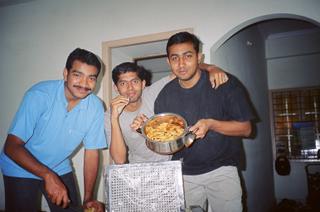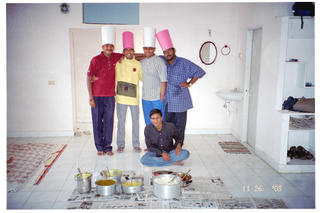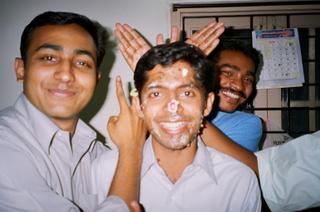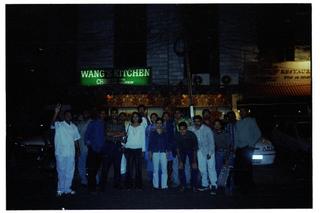The giant in the sky
The giant is a superjumbo jet, which will carry 555 passengers (when configured for three classes of seating), with a wingspan stretching nearly the length of a football field—50 feet (15 meters) and wider than any commercial plane in the air today. It is Airbus A380, called "green giant" by Airbus itself (green since it is environment friendly as claimed by Airbus).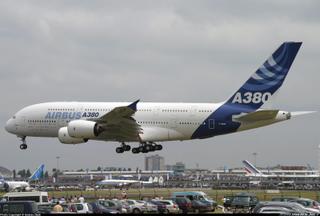
The 555 seat, double deck Airbus A380 is the most ambitious civil aircraft program yet. When it enters service in March 2006, the A380 will be the world's largest airliner, easily eclipsing Boeing's 747.
Airbus began engineering development work on such an aircraft, then designated the A3XX, in June 1994. Airbus studied numerous design configurations for the A3XX and gave serious consideration to a single deck aircraft which would have seated 12 abreast and twin vertical tails. However Airbus settled upon a twin deck configuration, largely because of the significantly lighter structure required.
Key design aims include the ability to use existing airport infrastructure with little modifications to the airports, and direct operating costs per seat 15-20% less than those for the 747-400. With 49% more floor space and only 35% more seating than the previous largest aircraft, Airbus is ensuring wider seats and aisles for more passenger comfort. Using the most advanced technologies, the A380 is also designed to have 10-15% more range, lower fuel burn and emissions, and less noise.
Several A380 models are planned: the basic aircraft is the 555 seat A380-800 (launch customer Emirates). The 590 ton MTOW 10,410km (5620nm) A380-800F freighter will be able to carry a 150 tonne payload and is due to enter service in 2008 (launch customer FedEx). Potential future models will include the shortened, 480 seat A380-700, and the stretched, 656 seat, A380-900.
On receipt of the required 50th launch order commitment, the Airbus A3XX was renamed A380 and officially launched on December 19, 2000. In early 2001 the general configuration design was frozen, and metal cutting for the first A380 component occurred on January 23, 2002, at Nantes in France. In 2002 more than 6000 people were working on A380 development.
On January 18, 2005, the first Airbus A380 was officially revealed in a lavish ceremony, attended by 5000 invited guests including the French, German, British and Spanish president and prime ministers, representing the countries that invested heavily in the 10-year, 10 billion+ ($13 billion+) aircraft program, and the CEOs of the 14 A380 customers, who had placed firm orders for 149 aircraft by then.
The out of sequence A380 designation was chosen as the "8" represents the cross-section of the twin decks. The first flight is scheduled for March 2005, and the entry into commercial service, with Singapore Airlines, is scheduled for March 2006.
Apart from the prime contractors in France, Germany, the United Kingdom and Spain, components for the A380 airframe are also manufactured by industral partners in Australia, Austria, Belgium, Finland, Italy, Japan, South Korea, Malaysia, Netherlands, Sweden, Switzerland and the United States. A380 final assembly is taking place in Toulouse, France, with interior fitment in Hamburg, Germany. Major A380 assemblies are transported to Toulouse by ship, barge and road.
On July 24, 2000, Emirates became the first customer making a firm order commitment, followed by Air France, International Lease Finance Corporation (ILFC), Singapore Airlines, Qantas and Virgin Atlantic. Together these companies completed the 50 orders needed to launch the programme.
Later, the following companies also ordered the A380: FedEx (the launch customer for the A380-800F freighter), Qatar Airways, Lufthansa, Korean Air, Malaysia Airlines, Etihad Airways, Thai Airways and UPS.
Four prototypes will be used in a 2200 hours flight test programme lasting 15 months.

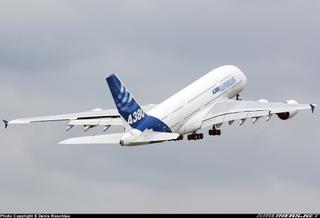
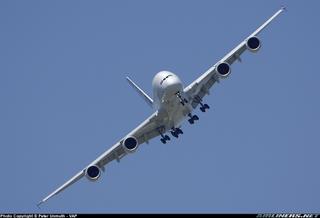
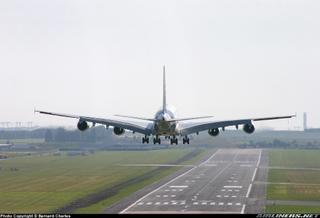
Weight
A380-800 - Operating empty 277,000kg (610,700lb), max takeoff 560,000kg (1,234,600lb).
A380-800F - Operating empty 252,000kg (555,600lb), max takeoff 590,000kg (1,300,700lb).
Dimension
A380-800 - Wing span 79.8m (261ft 10in), length 72,75m (238ft 8in). Height 24,08 m (79ft)
Capacity
A380-800 - Flightcrew of two. Standard seating for 555 passengers on two decks in a three class arrangement. Qantas plans to fit its aircraft with 523 seats (in three classes). A380 has 49% more floor area but only 35% more seats (in 555 seat configuration) than the 747-400, allowing room for passenger amenities such as bars, gymnasiums and duty free shops. Cargo capacity 38 LD3s or 13 pallets.
But not the biggest!
While it is the largest passenger airliner ever made, it is not the biggest airplane in the world -- this honor belongs to the Ukrainian An-225 Cossack.
The Cost of Greatness
Airbus has spent an estimated $13 billion on the development of the A380. The price for a single plane is listed at $285 million! Industry experts point out that airlines rarely pay full list price, especially if they order large numbers of planes, so it is difficult to determine exactly how many planes Airbus needs to sell to recoup the development costs.


